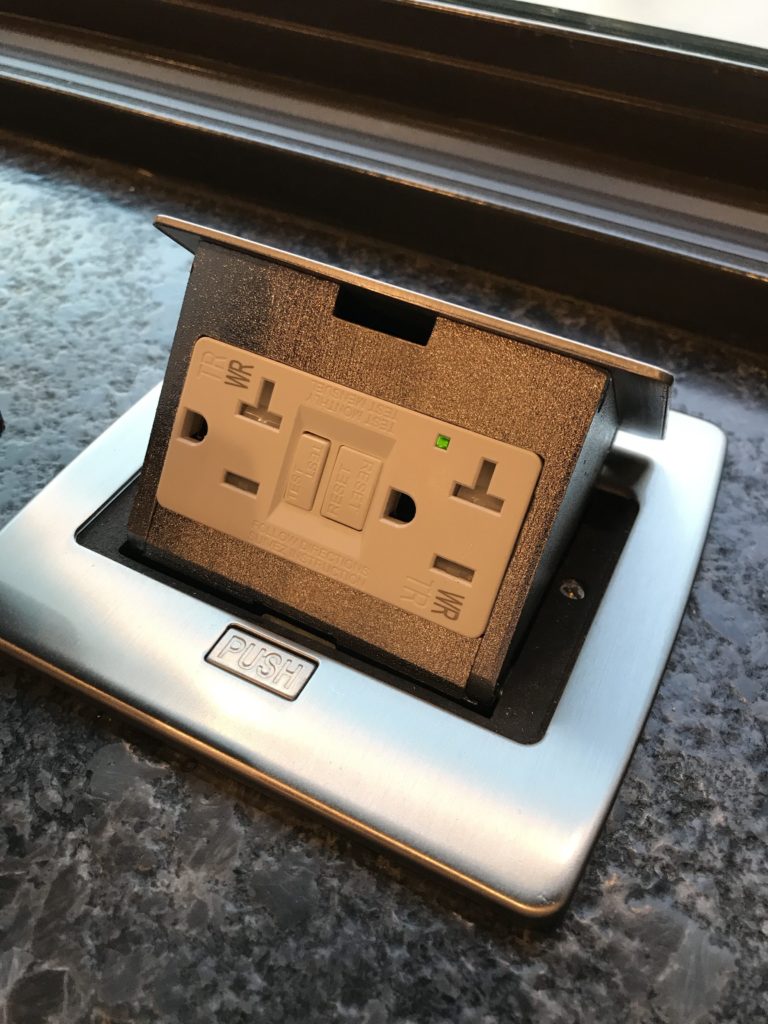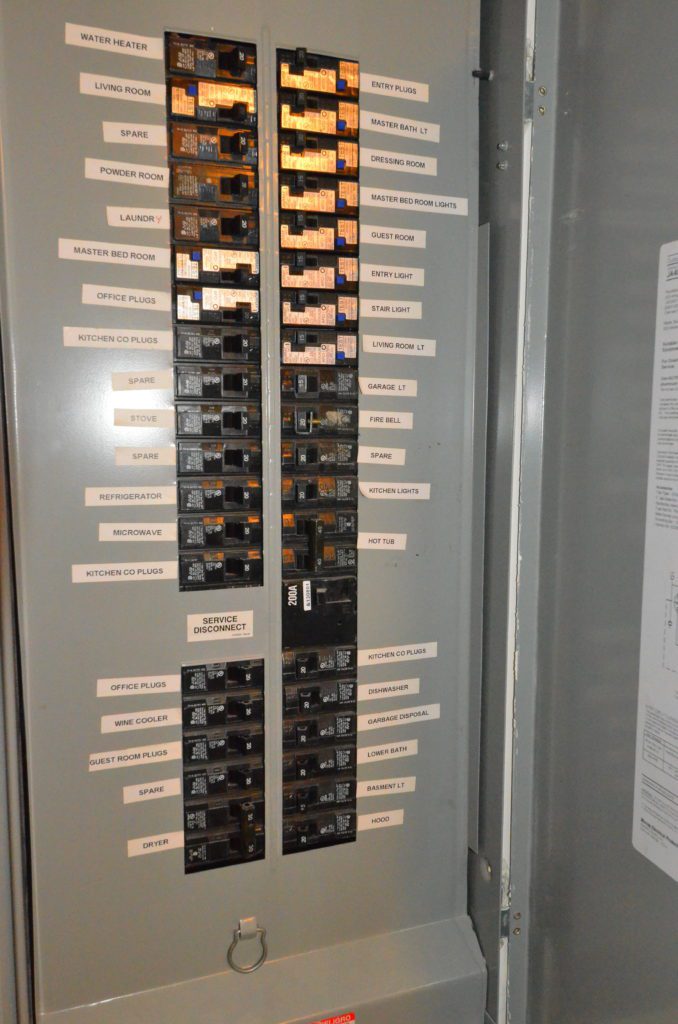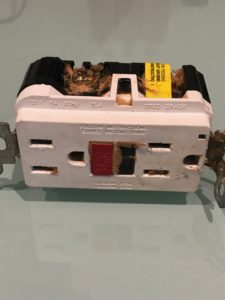GFCI’s help keep you safe, but don’t last forever!
It is always a bit frightening to learn that something meant to make your life safer has a deadly dark side. Today’s surprise villains are GFCI protected outlets… and they are everywhere. These outlets are a mandated part of your home electrical system and are designed to keep you safe from shock. They do a great job too, as long as they are working. Unfortunately, GFCI’s can silently fail leaving your life at risk. Regular service as described here can reduce the risk of failure, but most homeowners will never know, because although GFCI’s are mandated, proper maintenance is not.

Purpose of GFCI
GFCI stands for Ground Fault Circuit Interrupter. These are special electrical outlets in your home that stop the flow of electricity if any abnormal current flow takes place. Their purpose is to prevent a possible electric shock.
Starting in 1971, the electrical codes have required you to have GFCI outlets in your kitchen, around the backsplashes, and in each bathroom in your house. They are required in any potentially wet location. Also, any exterior outlets around your house, are required to be connected to a GFCI-protected circuit.
Types
There are two types of GFCIs. GFCI “circuit breakers” and GFCI “receptacles”. GFCI receptacles are used extensively inside the house where they are safe from weather and easier to reset. Circuit breaker types work better for protecting exterior outlets since they can be better sheltered in a service panel. The main disadvantages of GFCI circuit breakers over receptacles are cost and inconvenience (resetting). The advantage is circuit breaker types will typically outlast GFCI receptacles as they are not exposed to the rigors of the outdoors.
Most homeowners have had to “reset” a GFCI outlet at some point? You can do this by pressing the RESET button after it has tripped. GFCI’s can sometimes trip because of power surges, electrical storms, or just by overloading the circuit. The fact is, unless they have tripped, you probably don’t really think much about them. That could be a dangerous error.
How GFCI’s Work
A normal 120-volt outlet in the United States, has two vertical slots and then a round hole centered below them. The left slot is slightly larger and is the “neutral,” the right slot is the “hot”. The hole below them is called the “ground.” If an appliance is working safely, all electricity that it uses will flow from hot to neutral in exactly equal amounts.
A GFCI outlet monitors that current and if there is any imbalance in the flow, it trips the circuit. The GFCI senses any mismatch (as small as 4 milliamps,) and interrupts the circuit almost instantly (one-thirtieth of a second.) These specs are important because at around 10 milliamps, human muscles will lock up from electrical shock, making them unable to release whatever is causing the shock. Just two seconds of sustained current can cause death.
Mechanics

When the reset button is pressed, the spring-loaded contacts close, allowing current to pass. An internal solenoid connected to a sensing coil keeps the contacts closed.
The sensing coil surrounds (but is not electrically connected to) the hot and neutral conductors. In normal operation, the current moving down the hot conductor returns up the neutral conductor and the currents are equal and opposite and cancel each other out.
Any fault to ground, caused for example by a person touching a live component in the attached appliance, will cause some of the current to take a different return path, creating an imbalance in the current flow.
This imbalance causes a current in the sensor coil which then releases the spring-loaded contacts and cutting off the electricity supply to the appliance.
All this happens in milliseconds, greatly reducing the chances of a dangerous shock being received.
The test button allows the correct operation of the device to be verified. This simulates a fault by creating an imbalance in the sense coil. If the GFCI does not trip when this button is pressed, then the device must be replaced.
GFCI Outlet Service Life
GFCI outlets don’t last forever. This means that some of yours may no longer be protecting you as they should. Functional GFCI outlets likely save thousands of lives every year by preventing electrical shocks from wet hands, improper use of extension cords, touching bare exposed wires etc. But only if they are working.
The average GFCI outlet has a service life of only 10 years. If your home is older than that, there’s a good chance that at least some of your GFCI outlets aren’t working properly. If your area is subject to corrosion, high humidity and/or frequent storms or power surges, it is possible for GFCI outlets to become non-functional in 5 years or even less.
Compounding the problem, contractors and developers often buy GFCI’s in bulk which usually nets the most cheaply made units on the market. Using higher quality receptacles will give a longer life span so buy specification grade, commercial grade, or hospital grade. These are much higher quality GFCI’s for just a few dollars more.
Testing your GFCI

The best way to see if your GFCI outlet is still doing its job is to test it. To do so, the outlet must be powered up. An unpowered GFCI outlet can’t be tested, and it won’t allow you to reset it until it’s powered.
The simplest way is to press the TEST button on the outlet. Doing this creates a fault to ground and interrupts the flow of electricity. This in turn pops out the spring-loaded RESET button. You can then press the RESET button to reconnect the circuit and resume normal operation. Common GFCI outlets have a red TEST button and a black RESET button, though newer outlets may look different.
Press the TEST button and if the GFCI doesn’t trip, replace it as soon as possible. If your test causes the outlet to trip but the RESET button won’t reset, that means it needs to be replaced (it probably wasn’t protecting you anyway). A GFCI outlet can’t be reset if it’s not getting power so check that the breaker isn’t tripped before deciding that the GFCI outlet is faulty.
You should test your GFCI outlets ay least quarterly. It’s extra work, but it really could save your life.
Outlet Testers
The best way to test a GFCI outlet is with a device that actually creates a ground such as this Triplett Plug-Bug:
GFCI outlet tester

I get them for my entire crew here for under $7 on Amazon. Just plug it into the outlet, press the button on the tester and see whether your GFCI outlet trips. Testers like this one have Indicator lights to show whether any outlet (GFCI or standard) is wired properly. It can identify common problems like an open ground, open neutral, open hot, or reversed wires. Sometimes an outlet will not look like a normal GFCI but the when tested the circuit will go dead. In that case you either have a GFCI breaker in the main panel, or the outlet you tested is “downstream” from another GFCI outlet located somewhere else. If so you will need to search for the breaker or outlet and reset.
Replacement Protocol
There is no way to take outlets apart to make repairs. If they are found to be defective they must be replaced. Here is the replacement protocol HPS recommends to their clients: Use a tester to check and verify GFCI operation every quartier. For the first five years replace one at a time as needed. After five years when one fails, replace them all.
I save money by buying high quality GFCI outlets in quantities. I recommend these 15A GFCI outlets by Eaton. Eaton makes great quality products but what I really like is that these GFCI outlets do a regular self-test. A blinking red LED indicator means they’ve reached the end of their service life and need to be replaced. If you don’t have HPS. or can’t remember to manually test your GFCI outlets regularly, using these self-testing versions are a good option. NOTE: Make sure when ordering to match color with your existing outlets and switches.
Safety First
Testing your own GFCI outlets is definitely something any homeowner can (and should) do. Replacing a GFCI outlet that has reached the end of its service live is something average homeowners should leave to a professional licensed electrician. If you ignore this advice, just know that with any electrical work, it’s important to follow safety procedures such as shutting off the circuit at the breaker and testing all wires in an outlet box before touching anything. This is particularly important in boxes that contain more than one outlet and/or switch. Never assume that a wire is dead. Always use an electrical circuit tester before touching anything. If you don’t have one, you can get a circuit tester in a set with a GFCI outlet tester for less than $15. These are good tools that every homeowner should have.
Summary and Recommendations
GFCI outlets wear out and fail after a few years much like smoke and CO detectors. It is highly likely that some of your GFCIs have failed or are way past their intended service life. With your own tools, you can safely test your GFCI outlets. Have a licensed electrician replace any failed outlets. Another problem to avoid is locating a master GFCI (a GFCI controlling a number of non-GFCI outlets) in a closet or some other difficult to find location. These can be time consuming and frustrating to find when tripped.
History of GFCI code changes
Various GFCI code enactments:
1971 Receptacles within 15 feet of pool walls
1971 All equipment used with storable swimming pools
1973 All outdoor receptacles
1974 Construction Sites
1975 Bathrooms, 120-volt pool lights, and fountain equipment
1978 Garages, spas, and hydro-massage tubs
1978 Outdoor receptacles above 6ft.6in. grade access exempted
1984 Replacement of non-grounding receptacles with no grounding conductor allowed, pool cover motors and distance of GFCI protection extended to 20 feet from pool walls
1987 Unfinished basements, Kitchen countertop receptacles within 6 feet of sink, Boathouses
1990 Crawlspaces (with exception for sump pumps or other dedicated equip.)
1993 Wet bar countertops within 6 feet of sink
1993 Any receptacle replaced in an area presently requiring GFCI
1996 All kitchen counters – not just those within 6 feet of sink, All exterior receptacles except dedicated de-icing tape receptacle, Unfinished accessory buildings at or below grade
1999 Exemption for dedicated equipment in crawlspace removed
Details and actual codes can be found here…
https://www.nachi.org/forum/showpost….18&postcount=1
Help me to help you
Thank you for taking time to use this free website. I hope you find the junk-free information here fun and useful? Please send me your comments and feedback.
Writing and maintaining the information in this manual is a lot of hard work. By sharing these pages with your friends, you help me to continue the effort. You can easily share these pages to all your favorite social media sites via the shortcut buttons on the sidebar. You can also simply email the page link to your friends. Please share often.
The very best way to help me happens when you use the embedded links to buy things. Using a link is easy and free, yet it provides a great source of support for this site. The vendors I’ve chosen to link to have proven to be trustworthy and are the very best resources available. That is why I recommend them personally.
HomePreservationManual.com is the place to visit if you want information on
- maintaining your home
- how to improve air quality
- ways to improve the real value of your home
- what are the best housekeeping services
- the problems with handymen services
- how to plan and execute home renovation and home improvement projects
- tips for spring cleaning; tidying up a messy house
- and generally how to be a better homeowner.
Make sure you download your monthly maintenance checklist for this month.
Linking to this site
Do you want to link to anything on this site? Please do! Go right ahead. I appreciate it and am honored to be considered as a resource on your website. Always feel free to link to anything you find helpful. Of course, please never copy anything (everything is copyrighted and registered), but link away and thanks!
Thank you!
Copyright and permission to use information.
If you have questions or just want to say hi, please send me a note. If you are looking for help performing the work described and you are in the San Francisco area, go to HPS Palo Alto Inc.and request a free evaluation.
As a reminder, it is unlawful to make copies including cut and paste or especially in the form of making printouts for reuse. If you wish to make a print for personal use, I will happily grant you one-time permission if you will kindly send me a request in writing.
Thanks again!







